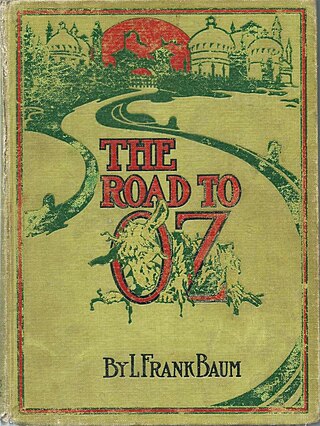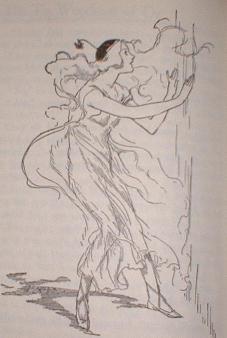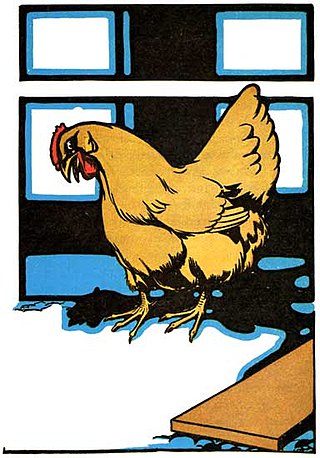
The Patchwork Girl of Oz by L. Frank Baum is a children's novel, the seventh in the Oz series. Characters include the Woozy, Ojo "the Unlucky", Unc Nunkie, Dr. Pipt, Scraps, and others. The book was first published on July 1, 1913, with illustrations by John R. Neill. In 1914, Baum adapted the book to film through his "Oz Film Manufacturing Company."

The Road to Oz: In Which Is Related How Dorothy Gale of Kansas, The Shaggy Man, Button Bright, and Polychrome the Rainbow's Daughter Met on an Enchanted Road and Followed it All the Way to the Marvelous Land of Oz. is the fifth of L. Frank Baum's Land of Oz books. It was originally published on July 10, 1909 and documents the adventures of Dorothy Gale's fourth visit to the Land of Oz.

Ozma of Oz: A Record of Her Adventures with Dorothy Gale of Kansas, Billina the Yellow Hen, the Scarecrow, the Tin Woodman, the Cowardly Lion and the Hungry Tiger; Besides Other Good People Too Numerous to Mention Faithfully Recorded Herein, published on July 30, 1907, was the official third book of L. Frank Baum's Oz series. It was the first in which Baum was clearly intending a series of Oz books.

Tik-Tok of Oz is the eighth Land of Oz book written by L. Frank Baum, published on June 19, 1914. The book has little to do with Tik-Tok and is primarily the quest of the Shaggy Man to rescue his brother, and his resulting conflict with the Nome King.

Princess Ozma is a fictional character from the Land of Oz, created by American author L. Frank Baum. She appears in every book of the Oz series except the first, The Wonderful Wizard of Oz (1900).

The Land of Oz is a magical country introduced in the 1900 children's novel The Wonderful Wizard of Oz written by L. Frank Baum and illustrated by W. W. Denslow.

The Deadly Desert is the magical desert in Nonestica that completely surrounds the fictional Land of Oz, which cuts it off from the rest of the world.

Tik-Tok is a fictional "mechanical man" from the Oz books by American author L. Frank Baum. He has been termed "the prototype robot", and is widely considered to be one of the first robots to appear in modern literature, though the term "Robot" was not used until the 1920s, in the play R.U.R.

The Scarecrow is a character in the fictional Land of Oz created by American author L. Frank Baum and illustrator W.W. Denslow. In his first appearance, the Scarecrow reveals that he lacks a brain and desires above all else to have one. In reality, he is only two days old and merely naïve. Throughout the course of the novel, he proves to have the brains he seeks and is later recognized as "the wisest man in all of Oz," although he continues to credit the Wizard for them. He is, however, wise enough to know his own limitations and all too happy to hand the rulership of Oz, passed to him by the Wizard, to Princess Ozma, and become one of her trusted advisors, though he typically spends more time having fun than advising.

The Nome King is a fictional character created by American author L. Frank Baum. He is introduced in Baum's third Oz book Ozma of Oz (1907). He also appears in many of the continuing sequel Oz novels also written by Baum. Although the character of the Wicked Witch of the West is the most notable and famous Oz villain, it is actually the Nome King who is the most frequent antagonist throughout the entire book series.

Polychrome is a cloud fairy and the youngest daughter of the Rainbow, thus she is a "sky princess". She first appears in The Road to Oz (1909), which is the fifth book of the original fourteen Oz books by American author by L. Frank Baum. She also appears several times in later Oz stories of the classic series, and has a titular role in the modern sequel Polychrome: A Romantic Fantasy by Ryk E. Spoor.

Billina is a fictional character in the classic children's series of Oz books by American author L. Frank Baum. She is introduced in Ozma of Oz (1907).

The Magical Mimics in Oz (1946) is the thirty-seventh in the series of Oz books created by L. Frank Baum and his successors, and the first written by Jack Snow. It was illustrated by Frank G. Kramer. The book entered the Public Domain in the United States, when its copyright was not renewed as required.

The Shaggy Man of Oz (1949) is the thirty-eighth in the series of Oz books created by L. Frank Baum and his successors, and the second and last by Jack Snow. It was illustrated by Frank G. Kramer. The book entered the public domain in the United States when its copyright was not renewed as required.

The Wonderful Wizard of Oz, known in Japan as Ozu no Mahōtsukai, is a Japanese anime television series adaptation based on four of the original early 20th century Oz books by L. Frank Baum. In Japan, the series aired on TV Tokyo from 1986 to 1987. It consists of 52 episodes, which explain other parts of the Oz stories, including the events that happened after Dorothy returned home.

The Land of Ev is a fictional country in the Oz books of L. Frank Baum and his successors. The country was first visited in Baum's third Oz novel, 1907's Ozma of Oz, and was the first of Baum's countries that surround the Land of Oz. This book introduced the Nome King, a recurring villain who lives underground beneath the Land of Ev.

Queen Ann in Oz is a 1993 children's novel written by Karyl Carlson and Eric Gjovaag, and illustrated by William Campbell and Irwin Terry. As its title indicates, the book is an entry in the large and growing literature on the Land of Oz, begun by L. Frank Baum and continued by many successors.
Dorothy Meets Ozma of Oz is a 1987 direct-to-video animated short film introduced by Michael Gross of Family Ties. It is based on the 1907 novel Ozma of Oz by L. Frank Baum.
The Tik-Tok Man of Oz is a musical play with book and lyrics by L. Frank Baum and music by Louis F. Gottschalk that opened at the Majestic Theatre in Los Angeles, California on March 31, 1913. It is loosely inspired by Baum's book Ozma of Oz (1907), incorporates much of the material from Baum's book The Road to Oz (1909), and was the basis for his 1914 novel, Tik-Tok of Oz. It was promoted as "A Companion Play to The Wizard of Oz" and directed by Frank M. Stammers. The play is known from its advertising and published music, but survives only in earlier manuscript.














